By: Len 'Viking1' Hjalmarson
Date: 1999-09-17
Our last update on Super Hornet was post E3 back in June. We've been pounding on the doors since then trying to get information, but it's been tight.
Finally, now that ECTS is over, DI is releasing new information and yesterday I received a beta for some hands on stick time. Remembering what I saw back at E3 in Los Angeles, I was excited to fire this one up!

Carrier Ops!!
I wasn't disappointed. The carrier ops are simply magnificent! Where Wayward is going with onboard crew action, DI have gone with carrier ops. They have animated the Catapult Crew, Plane Directors and Landing Signal Officers, complete with every hand signal and operation actually completed onboard the Ronald Reagan.
Before I tell you more, let me share my first two screen shots...
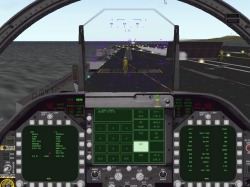
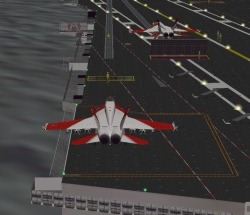
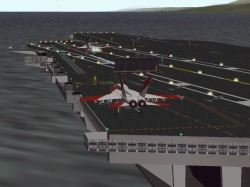
After installing the game, I watched about a five minute movie that provides background information for the war you will be involved in. WOW. It was excellent! Then after setting some PREFS (cranking everything to the max) I dove into a Training mission... Carrier Takeoff and Landing, what else?
Finding myself in the cockpit, my first impressions as I watched the deck crew then panned the view left and saw the ocean rolling by... I was bowled over. I felt like I was part of the action in an entirely new way.

I watched as the Plane Director and Cat crew prepped a Hornet beside me for launch and then watched as he launched (see left). Then another Hornet unfolded its wings and positioned in front of the Plane Director. I watched the procedure with fascination (I hadn't yet read the manual.) Suddenly I was getting COMMS that it was my turn, and the Plane Director in front of me was giving me an evil signal...
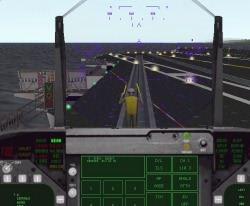
Now it was my turn! As I looked frantically about the cockpit for the engine controls I noticed that my left DDI had what appeared to be a takeoff checklist. Hey! Somebody was thinking when they designed this thing!

My next discovery was a switch labelled APU (Aux Power Unit) in the lower left cockpit. I clicked it ON and then flipped on the Left and Right engine switches and heard myself report that I was powering up. I knew enough to turn on the wheel brakes and I also knew which key it was. The Plane Director was very pleased.

I opened the throttle slightly and released the brakes and taxied forward, hitting the brake switch off and on to control my speed. When I got very close to the Plane Director (Do these guys carry plenty of insurance?) he raised the light sticks over his head and crossed em for good luck! (Hey, joking ok!)

Since I had successfully stopped the Hornet, he lowered the sticks to his side and breathed a heavy sigh of relief. As I sat there wondering what to do next I realized I was in big trouble. I had no idea!
Hmm. As I pondered I began to wonder about flaps. I found the key required and put my flaps at half extended position. No go, my Director was still waiting for me to do something else. I wondered what would happen if I continued forward...

I killed him. Yes, I am probably facing a court martial. Realizing what I had done I hit full burners and tried to get off the deck. Bad move. Ah well, I consulted the manual and discovered I needed to extend the Launch Bar.
Back on deck, I followed procedure. This time the Plane Director waved me forward. Up ahead I saw another deck officer with his arms raised (probably praying.)

Now in position and on the CAT, I notice a couple of CAT crew run over to my Hornet and are doing something.

Finally, they quit making weird motions, and in position and on the CAT, the Plane Director can get out of the way.

This is a GOOD THING™ since now I can do my thing and light the burners. I do so and hear myself call that the burners are lit.

I roll along the deck, accelerating to 165 knots in 2 seconds. Barely able to breathe and wondering why I test these things anyway, I am suddenly rewarded by the heart stopping experience of becoming airborne off the deck of the Ronald Reagan.



Too complicated for you? Actually, this is barely scratching the surface. F/A18 E looks to be the most authentic simulation of the F18 Hornet to date. I spent some time with IMagic's simulation, and there are systems simulated in this new DI release that I never heard of before.

On the other hand, the preferences will allow even the novice to enjoy this game. And if your system is less than what I am running (AMD K6-3 450 with 128 MB), no worries. The sim allows great configurability along a number of parameters for the hardware challenged.

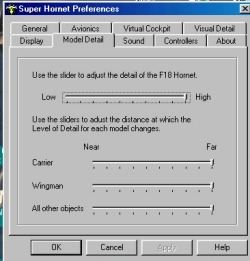
Not only that, but like the F22 the F/A 18E is designed to reduce pilot workload. The check lists that are accessible via your data displays will help you to do it right. Notice on the shot below that both FLAPS and HOOK are highlighted in red, telling me I need to do something with these systems prior to launch clearance.

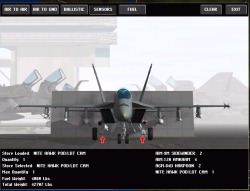
While the simulation appears to have depth that exceeds my expectations, there is some bad news as well. DI have decided to release Super Hornet in stages, in a manner very similar to the release of DiD's F22 ADF and Total Air War last year.
In short, the plan is to release Super Hornet now, complete with mission editor, but lacking the dynamic campaign and the COMMAND features talked about earlier. A later release, probably in spring, 2000, will contain a new theatre of operations and a fully dynamic campaign. No doubt this GOLD version will also contain updated graphics support for DX7 transform and lighting.
Go for the GOLD
Personally, I think this is a good compromise. I thought so with TAW, and I think so now. Why?

There are a number of reasons. First, because the complexity of the simulations we play has increased greatly the development team is much larger, meaning greatly increased costs to the developer. Yet the up front cost to the gamer hasn't changed much. In order for the developer to survive the challenge, they need to find a model that allows them to recoup their investment.
Secondly and related to the first reason, the increased complexity means that the development cycle is longer. This means a longer period of time before the developer can reap a harvest from their investment. Releasing a simulation in stages means they can recoup their investment sooner, and also use some of that income to continue to develop the sim.

Third, ongoing development of a single simulation means still greater complexity and more features. Additional time into F/A18 E Super Hornet means we will end up with a better product in the long run, with even more features. I think it's really a win-win situation in the end. DI has stated that a discount for the GOLD version will be available. And this way we get to play the game sooner!
Having told you this much, let me recap by noting that there will be a Mission Editor with this initial release, but the later GOLD version will include the planned COMMAND module that will allow you to play a fully dynamic campaign, and like MiG Alley, edit, add or adapt missions to your hearts content!

And then following the GOLD edition, another game will ship that will interface with the F/A 18 universe: Tornado II! By the time this one ships it's possible that like Microprose with their F15 module following Falcon 4, DI will have to upgrade the original F/A 18E release to a new graphics engine. Somewhere in here, if all goes according to plan, we will also see a Harrier module for the DI battlefield.

Cut from the movie intro..
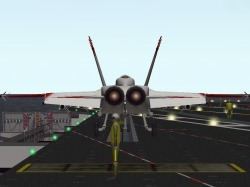


GMT: Zoom Shot Below..
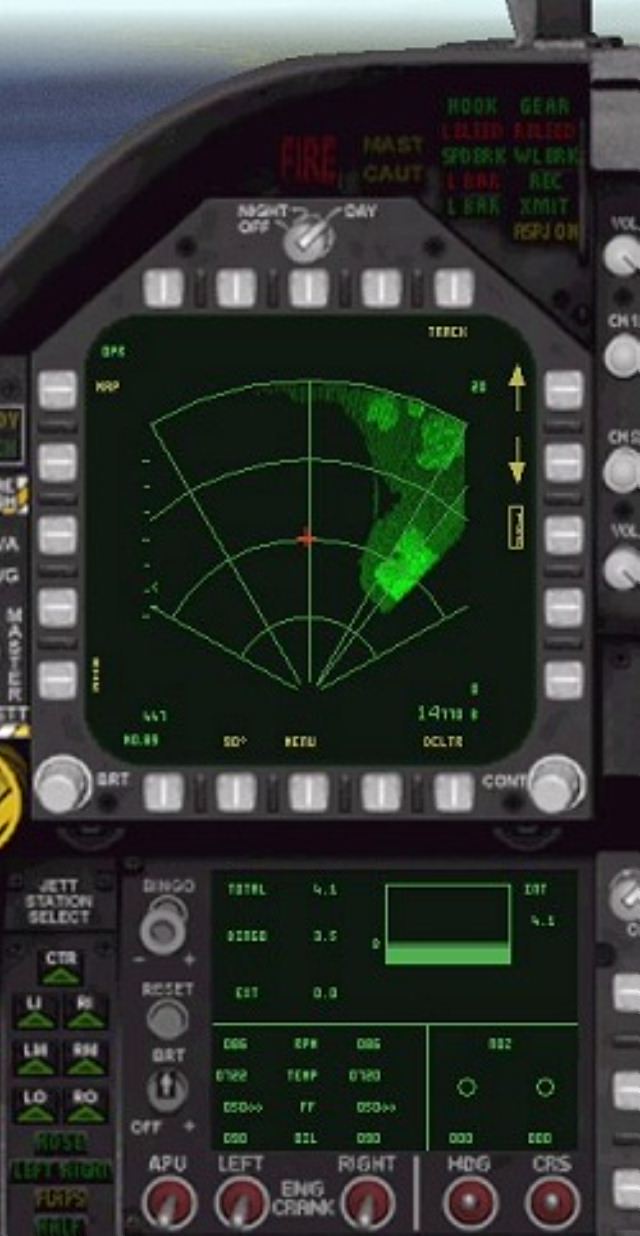
Yes, all these switches work!
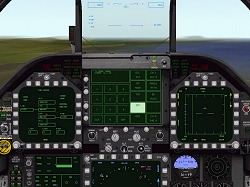
Four radio frequencies keep you active.
This afternoon I spent another two hours with the Super Hornet beta. My first goal was carrier landing. My second was to try some action in an Air to Ground mission. (For the earlier report, click HERE.)
In order to accomplish these goals I had to fire up the PDF manual for a little more information. In the process I had a chance to evaluate the manual, and I think that this could be the most detailed manual since Falcon 4.0! Not only does the manual cover every operation of the Super Hornet in detail, but it provides a good indication that DI's simulation is the most detailed yet. Consider that iMagic's simulation only needed a 140 page manual to cover avionics and operations.
What this means is that only experienced virtual pilots should seriously consider this simulation. Although there are some great helps available via the preferences and even a general difficulty slider (which applies to the enemy AI), there is a lot to learn here and only dedicated weekend pilots (who take time to read the manual) are likely to survive the effort.
I did indeed read the manual and discovered that the Super Hornet will virtually land itself on the carrier once the pilot positions his aircraft correctly. However, it's a lot more fun to do it yourself! The LSO will talk you down, and the detail in the Frensel Lens system is by far the best ever seen.
Using the MPCD and TACAN, I was able to relocate the carrier from ten miles out, and I also contacted Carrier Control for active guidance. This is the first time I heard carrier comms using the MODEX system, which consists of three digits. The first indicates the squadron and the other two are simply numerical id within the squadron. I heard myself call FOUR-OH-ONE, CHECKING IN when I called for guidance. The carrier responded with FOUR-OH-ONE: Carrier Approach, heading THREE-ONE-ZERO, eight miles.

I didn't attempt the ACL system (Auto Carrier Landing) for these attempts. Instead I activated the ILS using my Up Front Display.

Things went fairly well for me the first time, until I dropped below glide slope about 300 meters out. I hit my burners and raised my gear for another go round.

Fresnel Lens

FLOLS
On my second attempt I didn't catch the glideslope early enough and went around again. My third attempt found me in good shape, and shortly after I passed the one mile call a window popped up on my display which was a zoom in view of the FLOLS! (Fresnel Lens Optical Landing System.)

Loaded for Bear
Believe it or not, I caught the No.2 wire on my third attempt! I was so tickled that I didn't take a screen shot! But I did remember to kill my engines.
Feeling lucky, I went next for an air to air mission. As you can see in the shot above, I was loaded to the max, with 14 AMRAAMs and 2 Sidewinders! I discovered that a full fuel load and full weapons load has some disadvantages!
My next mission was an air to ground strike, complete with three wingmen.

At the beginning of this mission I found myself on a carrier deck that was literally humming with activity! Luckily, the technology exists to see in the dark.


Interrupted by the realities of life, I was barely off the carrier when I had to scrub the mission. I'll try to get back to it tomorrow!
Our last update on Super Hornet was posted on September 20th, and now we have new in game shots for you.
These shots demonstrate the GMT and A2A weapon modes. If you ever played DI's F16 or one of their earlier jet sims, you will already be familiar with their head-lock system. Personally, I've always felt it was one of the best padlock methods ever built for PC sims. For those who aren't familiar, read on!

In the shot above I have locked an air target and my IFF has already identified the target as an enemy. The next shot shows you the head lock mode.

My gun pipper is radar locked on the target, and the headlock indicator information is superimposed at the top of the screen. As you can see, the horizon line indicates that I am banking to the right, and the nose of my aircraft is indicated at the center of that line. The target lock box slightly above and to the right shows the direction I need to pull. The entire box width represents my peripheral vision, and when the target passes outside that box I will lose my lock. This is the no cockpit view.

In another instance I am using the headlock mode with the fixed cockpit view and I have just pulled the cockpit onto the tail of the bandit. Once in range I released my Sidewinder and a moment later was satisfied with the explosion.



Virtual Cockpit
One of the nice factors in this action is that when I lose lock I instantly hear myself call, "I have lost lock," and when I reacquire, "I have re-acquired target." The SA is good. I also found the MiG 29 VERY challenging!

Ground Target Lock
In the shot above I have just clicked on my ground radar display to lock the indicated target. The red color shows that this target was locked into my computer prior to takeoff, or else uploaded to my onboard computer via data link.

After locking my target I selected a Maverick and then cycled the display to bring up the maverick camera image. The next shot is a zoom in image using the Maverick camera.

Finally, I took the shot!
